Genre: Action Developer: Gremlin Graphics Software Publisher: GameTek Players: 1 Released: 1993
When a certain blue hedgehog hit the scene in 1991, he sent a ripple through the gaming landscape worldwide. Sonic The Hedgehog revolutionized the genre of jump-’n-runs throughout. Suddenly, everyone wanted in on this new phenomenon. Now, platform games had to be fast and vast, and levels had to be explored in all directions, not just from left and right. The boom that followed not only push the Genesis forward in North America, but it was also felt across the Atlantic, all the way to Europe, where home computers still were the favorite gaming platforms. In the early nineties, one platform in particular was predominant in the UK and the rest of central Europe: the Commodore Amiga, and it was there where a certain mascot was born. One that local gaming magazine soon hailed as a new hero to rival the blue blur: Zool, Ninja of the Nth Dimension.
Zool arrived on the Amiga 500 home computer in 1992 and became an instant hit in Europe. Gaming magazines heaved praise upon praise on the platform’s new lead video game hero. In turn, the home computer versions of the game almost outsold the Mega Drive sales of Sonic 2 in his home country Great Britain. Zool became so popular that Commodore for a short time even considered to make him the official mascot of the ill-fated Amiga CD32 system (a deal that allegedly fell through because Gremlin didn’t manage to finish the game in time for the console’s release). Taking that into consideration, it seems only natural that the ninja should make the move over to the Genesis to try and beat his rival Sonic where it counted: on his home turf. The port was made, and when Zool arrived on the Sega flagship, the battle was on!
Before I dig into this game, let me make one thing clear: gaming magazines of the time always referred to the main character as an ant, possibly because his black ninja attire gave his body a rounded, almost segmented appearance. But black ants don’t have just four limbs, green skin, or frigging EARS, do they? So what kind of creature is Zool supposed to be? Well, he’s the protagonist of a mascot-based platformer, and the software company that created him is called Gremlin Graphics… I think you can figure that one out yourself from here on out. (Oh and by the way, sadly the character is completely unrelated to Z’uul, gatekeeper of Gozer the Gozerian…)
Another important distinction to make in advance: The game was first released in the European PAL regions, where it was published by Electronic Arts. Later the same year it was brought to North America by GameTek. However, the game wasn’t properly optimized for NTSC regions, resulting in an already fast-paced game getting even faster! This leads to a few problems, which I will discuss in detail later on.
What most people probably remember about the game is the theme of the first level, Candy World, as it touts product placement for Chuppa Chupps lollipops (the original Amiga version even included one of those in the game box). Also, the game is incredibly hard, almost to a painful degree. It IS possible to adjust the difficulty in the settings, but this only regulates how many items you need to collect before you can advance to the next stage, so you really don’t need to bother). The game feels even harder on the Mega Drive than it was on the Amiga, since the sprites are now bigger and need more screen space, meaning that you now see a smaller portion of the level onscreen. Many players back in the day never even managed to reach the second world, and the image of the first world with its brash presentation of Chuppa Chupps-suckers has embedded itself so deep into the public consciousness that many people actually believe the game to be simply adware. However, there is no product placement to be found in the other six worlds the Mega Drive/Genesis version of the game touts.
So anyway, to the game itself. In true tradition of Platform games, our intrepid ninja Zool must make his way through seven worlds, each with its own distinct theme: Candy Land, Tool Land, Music Land, Toy Land and so forth. Each level is separated into four different acts. In each of them you need to collect a given number of thematically appropriate items (sweets and fast food in Candy Land, for example) in order to proceed to the next stage. In the final act, a boss fight awaits, though it doesn’t necessarily occur at the very end of the labyrinthine levels but usually a short distance before the exit. Zool can pass obstacles and avoid enemies by jumping (via the B-button), punching or kicking them (A), shooting at them (A while in mid-air), or slashing them with his ninja sword (up and C simultaneously). Rounding out the arsenal are several power-ups, which include creating a doppelganger (and thus doubling Zool’s attack power), increased jumping range and the obligatory limited time invincibility.
The perceived rivalry with Sonic stems from the speed of the game. Our hero Zool is a nimble little ninja, and so he practically rushes through the levels at an almost breakneck pace. Unlike a certain hedgehog, he doesn’t need to gain much momentum. Almost immediately after pressing the D-pad he rushes off at full speed in the appointed direction. The game does a nice job in keeping up with the protagonist and scrolls along nicely – in the PAL version, that is. This is where the aforementioned problems with the NTSC adaptation (or the shoddiness of it) come in. The speed of the game is increased, so not only does our hero dash across the screen at an even faster pace, but so do the enemies. Not only does this make an already hard game even harder, it leads to other issues as well. For instance, where the presentation in the PAL version is pretty crisp and clear, while playing the Genesis version I noticed that the NTSC region suffered from the occasional flicker as well. The gameplay experience of the US release is definitely more unpleasant.
This is a shame, because once you get into the game, you’ll notice that a lot of love, thought and detail went into its conception and original production. Granted, a few of the enemies could have profited from a bigger range of animations. Zool himself, however, has quite a nice variety of moves in his arsenal. The levels are, as far as your typical platform game goes, rather original for the most part and lovingly and colourfully designed, though it seems the graphical department somewhat lost steam when it came to properly designing worlds five and seven (Toy World and Desert World). Still, if you search every nook and cranny and are willing to experiment a bit, you are in for a few nice surprises. For example, if you play a certain tune on one of the pianos in the second world (Music World), you get access to a nice bonus stage in the form of a side-scrolling shooter. The music is also very pleasant for the most part, and there is the occasional tune that is nicely fashioned to hum along to.
Is Zool: Ninja of the Nth Dimension a Sonic killer? Certainly not. The level design lacks polish at some places, and the unforgiving difficult, even on its easiest setting, can turn the game into an exercise in anger management. If you hone your skills though and do not mind a fast-paced challenge, you are in for a treat. The graphics are colorful and smooth, the sound is pretty catchy, and the overall gameplay is actually pretty fun. Just do yourself a favor and try to play the game in its original PAL setting: The lack of proper optimization of the NTSC version manages to cross the thin line between tough but pleasant gameplay and torturous experience.
SCORE: 7 out of 10

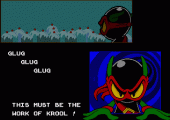
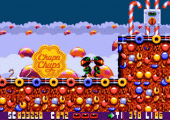
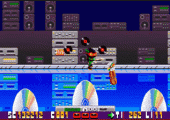
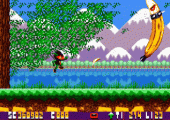
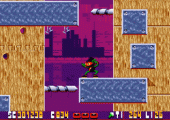
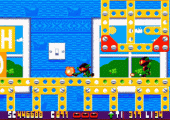
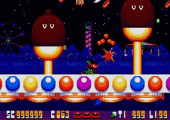
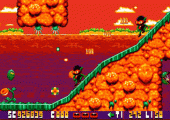
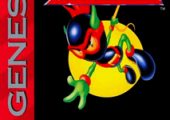
Recent Comments